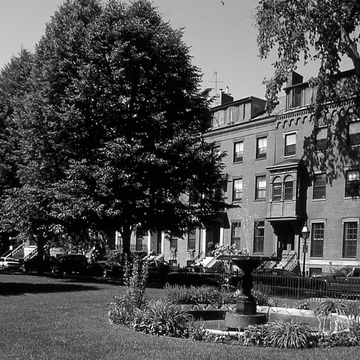Union Park remains the best preserved residential square in the South End. Filled with trees and encircled with a cast-iron fence, the elliptical residential park still represents the vision of the nineteenth-century city officials in developing the South End for Boston's growing middle class. Following examples on Beacon Hill, Ellis S. Chesbrough laid out the park, with the original cast-iron fence with lotus motif a copy of the one at Louisburg Square (BH24). Lots began to be auctioned in June 1851, and by 1859 all of the houses on the park were completed. Traditional Boston bowfront and square-front bay windows face the square. The decorative treatment is Italianate, although more conservative examples retain influences of the Greek Revival style. S. S. Woodcock designed 20 and 22 Union Park Street (NRD) in 1854, and Ryder and Fuller developed the group of six houses at 2–12 Union Park Street (NRD) in 1855. In 1909, Peabody and Stearns remodeled 20 and 22 Union Park Street for the headquarters and a men's residence of the South End House, one of the decentralized settlement house facilities throughout the South End.
You are here
Union Park
If SAH Archipedia has been useful to you, please consider supporting it.
SAH Archipedia tells the story of the United States through its buildings, landscapes, and cities. This freely available resource empowers the public with authoritative knowledge that deepens their understanding and appreciation of the built environment. But the Society of Architectural Historians, which created SAH Archipedia with University of Virginia Press, needs your support to maintain the high-caliber research, writing, photography, cartography, editing, design, and programming that make SAH Archipedia a trusted online resource available to all who value the history of place, heritage tourism, and learning.


